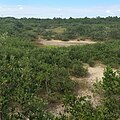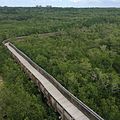| Weedon Island Preserve | |||||||||
|---|---|---|---|---|---|---|---|---|---|
IUCN category V (protected landscape/seascape) | |||||||||
 View of the preserve from top of observation tower | |||||||||
| Location | Pinellas County, Florida, US | ||||||||
| Nearest city | St. Petersburg, Florida | ||||||||
| Coordinates | 27°50′42″N82°36′07″W / 27.84500°N 82.60194°W | ||||||||
| Established | June 13, 1972 | ||||||||
| Governing body | Pinellas County Park Department | ||||||||
| |||||||||
The Weedon Island Preserve is a 3,190-acre natural area situated along the western shore of Tampa Bay and located at 1800 Weedon Drive NE, St. Petersburg, Florida, United States. It is predominately an estuarine preserve composed of upland and aquatic ecosystems such as mangrove forests, pine/scrubby flatwoods, and maritime hammocks, and is home to a variety of native wildlife. The preserve is also a designated archaeological area, with several shell mounds identified on the property that provide evidence of early peoples who inhabited the land for thousands of years.
Contents
- Recreational activities
- Weedon Island Preserve Cultural and Natural History Center
- Ecosystem
- Programs and events
- Hours of operations
- Gallery
- References
- External links
On June 13, 1972, Weedon Island Preserve was added to the U.S. National Register of Historic Places. In 1974, the state of Florida purchased Weedon Island and its surrounding islands, which were officially opened for public use in December 1980. In 1993, the state created a lease agreement with Pinellas County to manage and maintain the preserve. The county's Department of Parks and Conservation Resources presently manages the area.
Weedon Island Preserve's name is derived from Tampa doctor and amateur archaeologist Leslie Washington Weedon. [2]


















